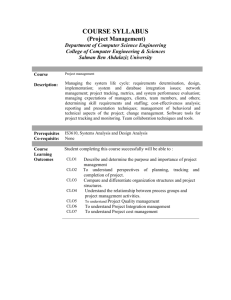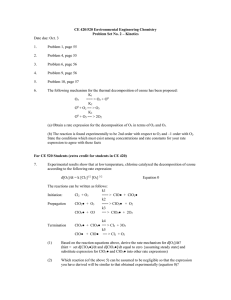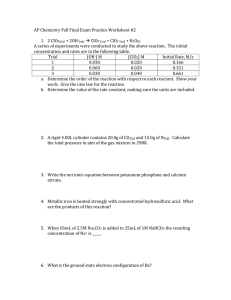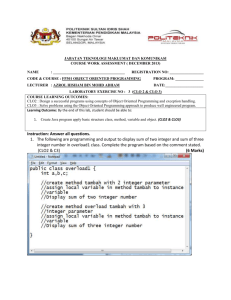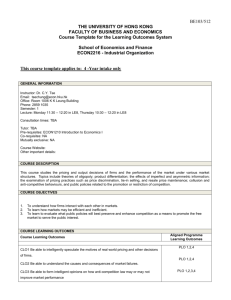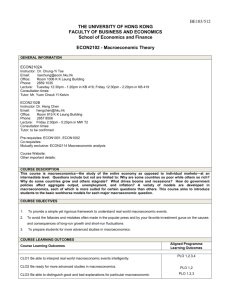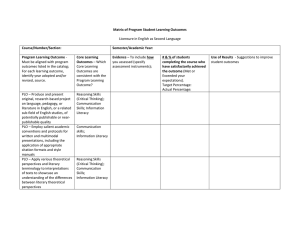Heat Transfer Lecture Plan - BDA 30603
advertisement
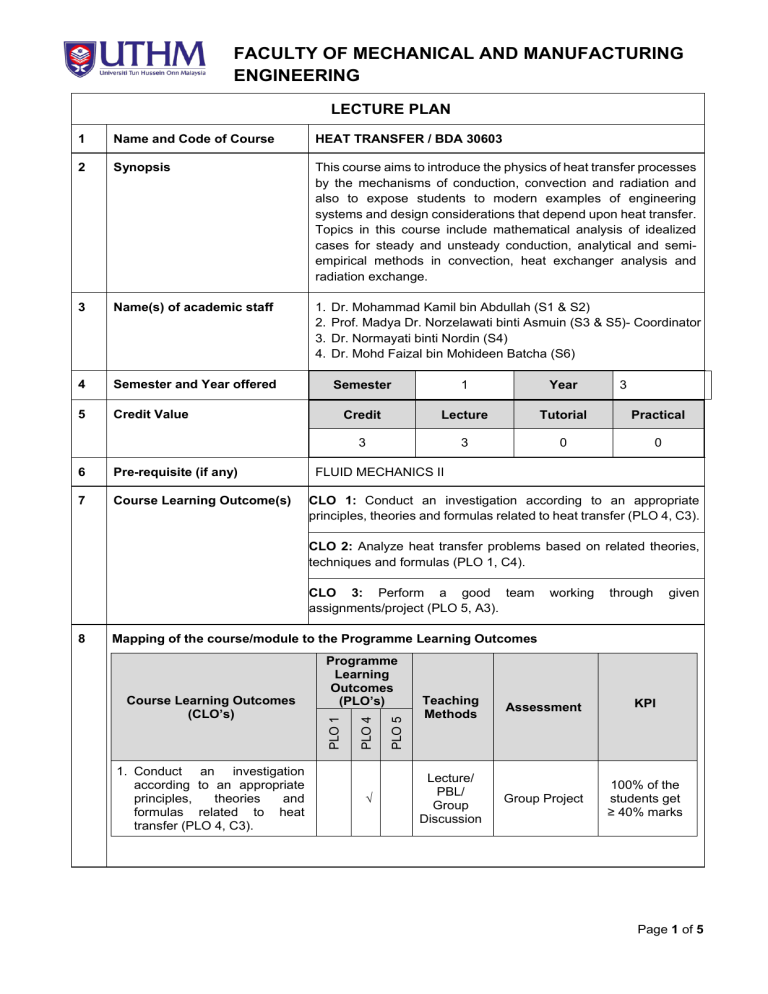
FACULTY OF MECHANICAL AND MANUFACTURING ENGINEERING LECTURE PLAN 1 Name and Code of Course HEAT TRANSFER / BDA 30603 2 Synopsis This course aims to introduce the physics of heat transfer processes by the mechanisms of conduction, convection and radiation and also to expose students to modern examples of engineering systems and design considerations that depend upon heat transfer. Topics in this course include mathematical analysis of idealized cases for steady and unsteady conduction, analytical and semiempirical methods in convection, heat exchanger analysis and radiation exchange. 3 Name(s) of academic staff 1. 2. 3. 4. 4 Semester and Year offered 5 Credit Value 6 Pre-requisite (if any) 7 Course Learning Outcome(s) Dr. Mohammad Kamil bin Abdullah (S1 & S2) Prof. Madya Dr. Norzelawati binti Asmuin (S3 & S5)- Coordinator Dr. Normayati binti Nordin (S4) Dr. Mohd Faizal bin Mohideen Batcha (S6) Semester 1 Year 3 Credit Lecture Tutorial Practical 3 3 0 0 FLUID MECHANICS II CLO 1: Conduct an investigation according to an appropriate principles, theories and formulas related to heat transfer (PLO 4, C3). CLO 2: Analyze heat transfer problems based on related theories, techniques and formulas (PLO 1, C4). CLO 3: Perform a good team assignments/project (PLO 5, A3). through given Mapping of the course/module to the Programme Learning Outcomes 1. Conduct an investigation according to an appropriate principles, theories and formulas related to heat transfer (PLO 4, C3). √ PLO 5 PLO 4 Course Learning Outcomes (CLO’s) Programme Learning Outcomes (PLO’s) PLO 1 8 working Teaching Methods Assessment KPI Lecture/ PBL/ Group Discussion Group Project 100% of the students get ≥ 40% marks Page 1 of 5 2. Analyze heat transfer problems based on related theories, techniques and formulas (PLO 1, C4). √ 3. Perform a good team working through given assignments/ project (PLO5, A3). √ Lecture/ PBL/ Group Discussion Tests/ Individual Assignments/ Final Examination 100% of the students get ≥ 40% marks PBL/ Group Discussion Group Project 100% of the students get ≥ 40% marks *Indicate the primary causal link between the CLO and PLO by ticking “√” the appropriate box. 9 Transferable Skills (if applicable) Skill(s) How to instill /develop the skills Assessment Method (Skills learned in the course of study which can be useful and utilised in other settings) Content outline of the course/module and the student learning time (SLT) per topic 1 Introduction 1.1 Heat Transfer Applications in Life 1.2 Applications in Engineering 1.3 1st and 2nd Law of Thermodynamics 1.4 Spontaneous and Driven Processes 1.5 Equilibrium and Steady State CLO1 CLO2 2.5 2-3 Conduction I 2.1 Modes of Heat Transfer 2.2 Thermal Conductivity 2.3 Heat Transfer Coefficient 2.4 Radiation Properties 2.5 1-D Steady Conduction 2.6 Uniform Heat Generation 2.7 Composite Bodies 2.8 Thermal Resistance Concept 2.9 Heat Transfer from Curved Surfaces 3.0 Critical Thickness of Insulation CLO1 CLO2 CLO3 6 0.5 Independent Learning (NF2F) CLO Others (e.g. SCL) Course Content Practical Week Tutorial Guided Learning (F2F) Guided Learning (NF2F) Teaching and Learning Activities Lecture 10 Total SLT 3 6 12 18 Page 2 of 5 4-5 Conduction II 3.1 Fins Theory 3.2 Fins Design, Performance Criteria and Fin Arrays 3.3 2-D Steady Conduction – Conduction Shape Factor 3.4 1-D Unsteady Conduction – Lumped System CLO1 CLO2 CLO3 5 CLO1 CLO2 CLO3 8.75 CLO1 CLO2 CLO3 2 CLO1 CLO2 8 1 6 12 18 27 1 3 6 1 18 24 Test 1 (24 October 2018) Dewan Peperiksaan F2 (Atas) 6-8 Forced Convection 4.1 Fluid Flow, Convective Heat Transfer and Friction 4.2 Boundary Layer Concept 4.3 Basic Equations 4.4 Use of Non-Dimensional Numbers 4.5 Laminar Flow & Turbulent Flow 4.6 Flow over a Flat Plate 4.7 Combined Boundary Layer 4.8 Flow over Bluff Bodies 4.9 Flow through Pipes 4.10 Flow Development 4.11 Reynold Analogy & Colburn Analogy 0.25 Mid Semester Break (4 – 10 November 2018) 9 Natural Convection 5.1 Natural Convection 5.2 Grashof Number 5.3 Mixed Convection 5.4 Free Convection Test 2 (4 December 2018) Dewan Peperiksaan F2 (Bawah) 10 - 12 Heat Exchangers 6.1 Overall Heat Transfer Coefficient 6.2 Co-flow, Counterflow and Crossflow 6.3 Log Mean Temperature Difference 6.4 Types of Heat Exchangers 6.5 LMTD – Design of Heat Exchangers 6.6 Effectiveness of a Heat Exchanger 6.7 Heat Exchanger Rating Page 3 of 5 13 - 14 Radiation 7.1 The Phenomenon of Radiation 7.2 Radiation Properties 7.3 Black Body & Grey Body 7.4 Spectral and Directional Dependence 7.5 Total Hemispherical Property 7.6 Radiation View Factor 7.7 Radiation Exchange between Surfaces 7.8 Radiation Resistance Network CLO1 CLO2 CLO3 4.75 0.25 1 12 18 37 1 4 72 114 Revision Week (23 – 29 December 2018) Final Examination (30 December 2018 – 19 January 2019) TOTAL Continous Assessment CLO Percentage (%) F2F NF2F Total SLT 1. Test 1 CLO2 15 1.5 - 1.5 2. Test 2 CLO2 15 1.5 - 1.5 3. Individual Assignments CLO2 5 - - - 4. Group Project CLO1 CLO3 15 - - - TOTAL 50 3.0 Final Assessment CLO Percentage (%) F2F NF2F Total SLT 1. Final Examination CLO2 50 3.0 - 3.0 TOTAL 50 3.0 TOTAL SLT 120 *F2F = face to face, NF2F=Non Face to Face 11 Identify special requirement of resources to deliver the course (e.g., software, nursery, computer lab, simulation room) 12 Main references supporting the course and Additional references supporting the course 1. Cengel, Y. A. and Ghajar, A., (2015). Heat and Mass Transfer: Fundamentals & Applications, 5thEdition. (SI Units), McGraw Hill, New York. 2. Bergman, T. L., Lavine A. S., Incropera, F. P. and DeWitt, D. P., (2011). Introduction to Heat Transfer, 6thEdition, John Wiley & Sons, New Jersey. 3. Holman, J. P., (2010). Heat Transfer, 10th Edition, McGrawHill, New York. Page 4 of 5 13 Other additional information 14 Course Attendance / Regulations 1. Students must attend not less than 80% of the contact hours for every course including Compulsory Attendance Course (Hadir Wajib – HW) and Attendance Only Course (Hadir Sahaja – HS). Pelajar mesti hadir tidak kurang dari 80% masa pertemuan yang ditentukan bagi setiap kursus termasuk kursus Hadir Wajib (HW) dan kursus Hadir Sahaja (HS). 2. Student who does not fulfill (1) of the above is not allowed to attend further lectures and is not allowed to sit for any further assessment. Zero mark (0) will be given to student who fails to comply with (1). As for Compulsory Attendance Course (Hadir Wajib – HW), student who fails to comply with (1) will be given Failure Attendance (Hadir Gagal – HG). Pelajar yang tidak memenuhi perkara (1) di atas tidak dibenarkan menghadiri kuliah dan tidak dibenarkan menduduki sebarang bentuk penilaian selanjutnya. Markah sifar (0) akan diberikan kepada pelajar yang gagal memenuhi perkara (1). Manakala untuk kursus Hadir Wajib (HW), pelajar yang gagal memenuhi perkara (1) akan diberi Hadir Gagal (HG). 3. Student must follow and obey all the University dress rules and regulations and must discipline themselves to avoid any disciplinary action. Pelajar perlu mengikut dan patuh kepada peraturan berpakaian Universiti yang berkuatkuasa dan menjaga disiplin diri masingmasing untuk mengelakkan dari tindakan tatatertib diambil terhadap pelajar. 4. Student must obey safety regulations during the learning and teaching process. Pelajar perlu mematuhi peraturan keselamatan semasa pengajaran dan pembelajaran. 15 Prepared by: Verified by: Name: Prof. Madya Dr. Norzelawati binti Asmuin Name: Prof. Madya Dr. Bukhari bin Manshoor Position: Course Coordinator Position: Head of Energy and Thermofluid Engineering Department Date: 30 August 2018 Date: 30 August 2018 Page 5 of 5
